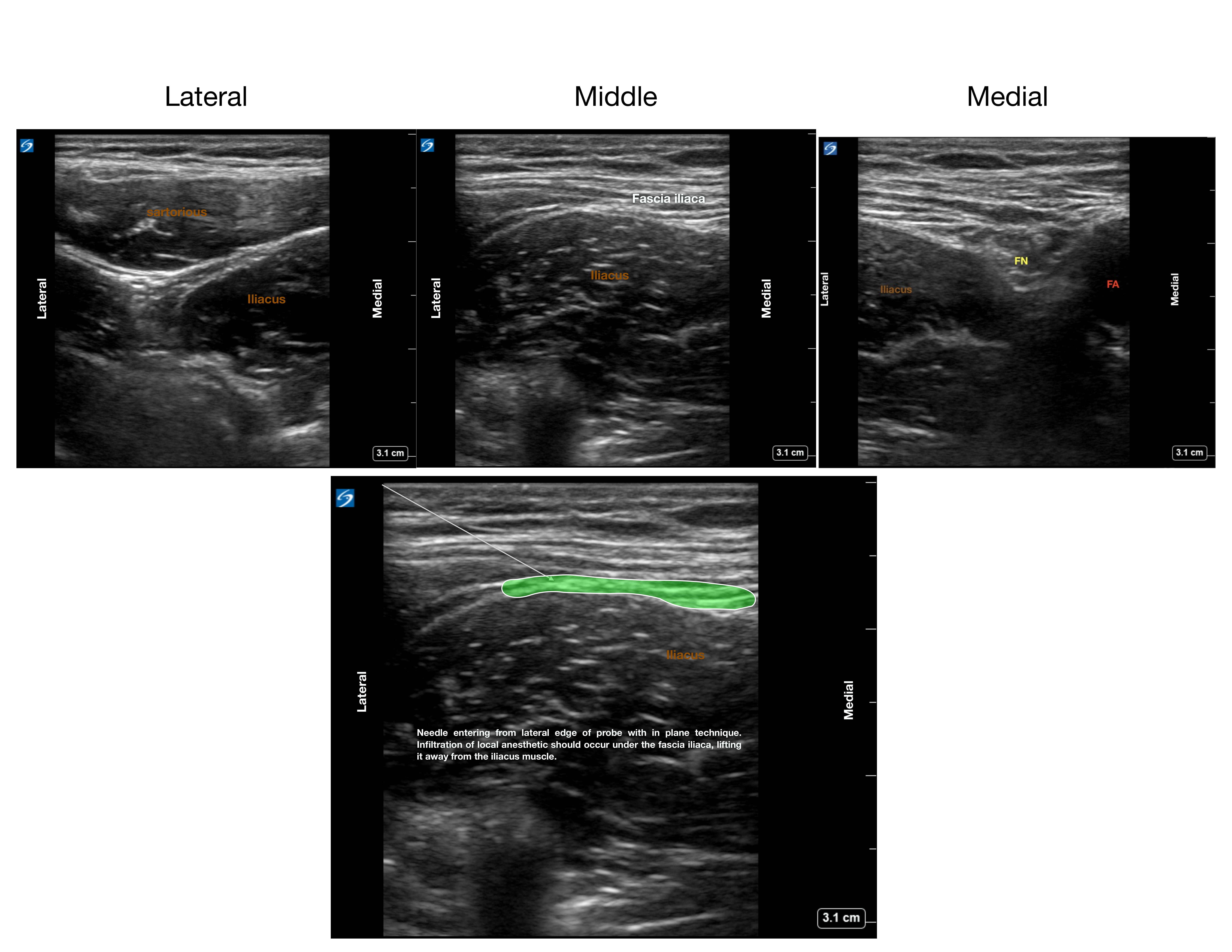[1]
Godoy Monzon D, Iserson KV, Vazquez JA. Single fascia iliaca compartment block for post-hip fracture pain relief. The Journal of emergency medicine. 2007 Apr:32(3):257-62
[PubMed PMID: 17394987]
[2]
Stevens M, Harrison G, McGrail M. A modified fascia iliaca compartment block has significant morphine-sparing effect after total hip arthroplasty. Anaesthesia and intensive care. 2007 Dec:35(6):949-52
[PubMed PMID: 18084988]
[3]
Foss NB, Kristensen BB, Bundgaard M, Bak M, Heiring C, Virkelyst C, Hougaard S, Kehlet H. Fascia iliaca compartment blockade for acute pain control in hip fracture patients: a randomized, placebo-controlled trial. Anesthesiology. 2007 Apr:106(4):773-8
[PubMed PMID: 17413915]
Level 1 (high-level) evidence
[4]
Haines L, Dickman E, Ayvazyan S, Pearl M, Wu S, Rosenblum D, Likourezos A. Ultrasound-guided fascia iliaca compartment block for hip fractures in the emergency department. The Journal of emergency medicine. 2012 Oct:43(4):692-7. doi: 10.1016/j.jemermed.2012.01.050. Epub 2012 Apr 9
[PubMed PMID: 22494596]
[5]
Høgh A, Dremstrup L, Jensen SS, Lindholt J. Fascia iliaca compartment block performed by junior registrars as a supplement to pre-operative analgesia for patients with hip fracture. Strategies in trauma and limb reconstruction. 2008 Sep:3(2):65-70. doi: 10.1007/s11751-008-0037-9. Epub 2008 Sep 2
[PubMed PMID: 18762870]
[6]
Dochez E, van Geffen GJ, Bruhn J, Hoogerwerf N, van de Pas H, Scheffer G. Prehospital administered fascia iliaca compartment block by emergency medical service nurses, a feasibility study. Scandinavian journal of trauma, resuscitation and emergency medicine. 2014 Jun 23:22():38. doi: 10.1186/1757-7241-22-38. Epub 2014 Jun 23
[PubMed PMID: 24957807]
Level 2 (mid-level) evidence
[7]
Aluisio AR, Teicher C, Wiskel T, Guy A, Levine A. Focused Training for Humanitarian Responders in Regional Anesthesia Techniques for a Planned Randomized Controlled Trial in a Disaster Setting. PLoS currents. 2016 Nov 16:8():. pii: ecurrents.dis.e75f9f9d977ac8adededb381e3948a04. doi: 10.1371/currents.dis.e75f9f9d977ac8adededb381e3948a04. Epub 2016 Nov 16
[PubMed PMID: 28018749]
Level 1 (high-level) evidence
[8]
Gasanova I, Alexander JC, Estrera K, Wells J, Sunna M, Minhajuddin A, Joshi GP. Ultrasound-guided suprainguinal fascia iliaca compartment block versus periarticular infiltration for pain management after total hip arthroplasty: a randomized controlled trial. Regional anesthesia and pain medicine. 2019 Feb:44(2):206-211. doi: 10.1136/rapm-2018-000016. Epub
[PubMed PMID: 30700615]
Level 1 (high-level) evidence
[9]
Sivakumar RK, Panneerselvam S, Cherian A, Rudingwa P, Menon J. Perineural vs. intravenous dexmedetomidine as an adjunct to bupivacaine in ultrasound guided fascia iliaca compartment block for femur surgeries: A randomised control trial. Indian journal of anaesthesia. 2018 Nov:62(11):851-857. doi: 10.4103/ija.IJA_397_18. Epub
[PubMed PMID: 30532320]
Level 1 (high-level) evidence
[10]
Ma YH, Wu J, Jia B, Xue JX, Wang TL. [Continuous fascia iliaca compartment block combined with oral analgesics for pre-operative pain control in elderly hip fracture patients]. Zhonghua yi xue za zhi. 2018 Mar 13:98(10):723-727. doi: 10.3760/cma.j.issn.0376-2491.2018.10.002. Epub
[PubMed PMID: 29562394]

